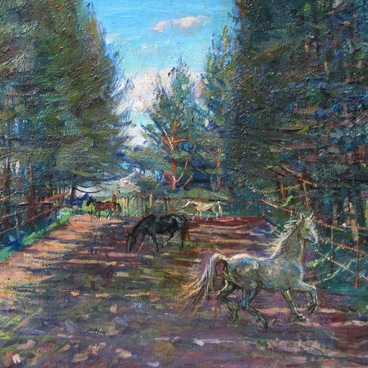The mountain landscape “Winter in the Mountains” which is housed in the Memorial Complex of Glory was painted by architect and artist Valery Rzhevsky in 2016. This is an easel painting in a realistic style.
Easel painting is an artwork that has an inherent meaning and can be perceived independently from the surrounding space and context. As a rule, such paintings are created on a portable support — an easel. Most often easel paintings are specifically separated from the surroundings with massive frames or wide mats (passe-partout).
Valery Rzhevsky depicted snow-white peaks in the background. Judging by the pointed peaks of the mountains, the artist chose the Greater Caucasus as the setting — the mountain range between the Black and Caspian Seas. It stretches for 1.150 kilometers from northwest to southeast, the width of the range in different places varies from 32 to 180 kilometers. Most of this mountain range is occupied by glaciers.
At the foot of the mountains, Rzhevsky depicted hills covered with coniferous forests with dense caps. A small mountain lake stands out in the foreground, its water flows down from a ledge. It is evident that severe frost has not yet arrived in the region, as the water is not covered with a crust of ice yet. However, a thick layer of fresh white snow can be seen on the shores. Near the lake, the artist depicted several trees with perfectly flat, leafless crowns.
In his painting, Rzhevsky opted for cool colors — the shades of white, blue, and emerald green. They emphasize the tranquility of the scene and silence.
Valery Rzhevsky was born on July 4, 1951, in Kuybyshev, presently known as Samara. In 1973, he graduated from the Architectural Department of the Kuybyshev Civil Engineering Institute, in 1979 he graduated from the Moscow Architectural Institute, and in 1985 — from the Leningrad Higher Military Civil Engineering School named after A. N. Komarovsky.
In 1978, Rzhevsky became a member of the Union of Architects, and in 2005 joined the Artists’ Union of Russia. His personal exhibitions were held in the halls of the Russian Academy of Arts in Moscow, as well as in Kazan, Cheboksary, Saratov, Vienna (Austria), Potsdam (Germany), Beijing and Harbin (China).
Easel painting is an artwork that has an inherent meaning and can be perceived independently from the surrounding space and context. As a rule, such paintings are created on a portable support — an easel. Most often easel paintings are specifically separated from the surroundings with massive frames or wide mats (passe-partout).
Valery Rzhevsky depicted snow-white peaks in the background. Judging by the pointed peaks of the mountains, the artist chose the Greater Caucasus as the setting — the mountain range between the Black and Caspian Seas. It stretches for 1.150 kilometers from northwest to southeast, the width of the range in different places varies from 32 to 180 kilometers. Most of this mountain range is occupied by glaciers.
At the foot of the mountains, Rzhevsky depicted hills covered with coniferous forests with dense caps. A small mountain lake stands out in the foreground, its water flows down from a ledge. It is evident that severe frost has not yet arrived in the region, as the water is not covered with a crust of ice yet. However, a thick layer of fresh white snow can be seen on the shores. Near the lake, the artist depicted several trees with perfectly flat, leafless crowns.
In his painting, Rzhevsky opted for cool colors — the shades of white, blue, and emerald green. They emphasize the tranquility of the scene and silence.
Valery Rzhevsky was born on July 4, 1951, in Kuybyshev, presently known as Samara. In 1973, he graduated from the Architectural Department of the Kuybyshev Civil Engineering Institute, in 1979 he graduated from the Moscow Architectural Institute, and in 1985 — from the Leningrad Higher Military Civil Engineering School named after A. N. Komarovsky.
In 1978, Rzhevsky became a member of the Union of Architects, and in 2005 joined the Artists’ Union of Russia. His personal exhibitions were held in the halls of the Russian Academy of Arts in Moscow, as well as in Kazan, Cheboksary, Saratov, Vienna (Austria), Potsdam (Germany), Beijing and Harbin (China).



